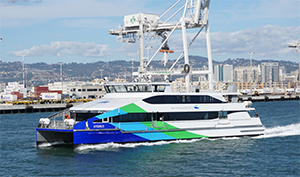Capt. Dushan Crawford gave a quick warning as he prepared to push off the terminal in Alameda, Calif., on the high-speed ferry Cetus.
“We do have a resident dinosaur on board,” he said with a wink. “We call it a bow thruster.”
“Listen to it growl,” said Capt. Greg Urban, who joined Crawford in the wheelhouse.
The Wesmar Vortex rumbled to life and moments later the 135-foot ferry edged away from Alameda Main Street Terminal. With the boat’s two pontoons pointed into the channel, Crawford throttled up on the twin MTU mains and churned toward nearby Jack London Square in Oakland.
Crawford is a 16-year captain with Blue & Gold Fleet, the company hired by the Water Emergency Transportation Authority (WETA) to operate its 13 high-speed vessels under the name San Francisco Bay Ferry. The latest additions to the fleet are 400-passenger ferries built by Seattle-based Vigor. Hydrus, the lead boat in the class, arrived last April, followed by Cetus three months later. The third vessel, Argo, is scheduled for delivery this spring, and the final boat is due in December.
Hydrus and Cetus bear the distinction as being the cleanest-operating 27-knot ferries in the U.S. The aluminum catamarans are each equipped with a urea-based exhaust aftertreatment system from Hug Engineering, allowing them to achieve EPA Tier 4 equivalent emissions.
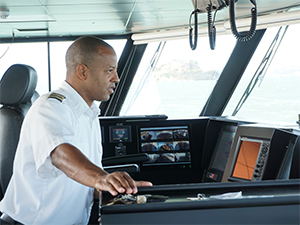 |
|
Capt. Dushan Crawford guides the high-speed Cetus away from Pier 41 into San Francisco Bay. Alcatraz Island is faintly visible in the distance. |
WETA spokesman Ernest Sanchez said the agency is required under California law to pursue Tier 4 equivalence or better for its new vessels. But its “green” ethos goes well beyond the propulsion system. The vessels use LED lights to reduce electrical loads and have seating made from eminently sustainable bamboo. Bridge electronics run on batteries charged by solar panels, and the hull is covered with vinyl rather than marine paint.
“WETA’s goal is to be as green as possible, not only for emissions,” he said. “All vessel systems, including coatings, lighting (and) fabrics, are reviewed for energy efficiency. Low environmental impact materials are sourced whenever possible.”
The $15.1 million ferries are much more than environmental showpieces. They’re designed for safety and convenience, with attention paid to passenger amenities. The vessels have wireless Internet, outlets for charging electrical devices, four heads and storage for 50 bicycles.
Crews find the vessels comfortable and well designed. The Furuno-equipped wheelhouse is spacious, with enclosed wing stations not found on some other WETA ferries. Crawford said the new class is also maneuverable and fuel efficient.
“These things just glide over water,” he said. “It’s really nice.”
Thirty minutes earlier, Crawford had backed Cetus off Pier 41 in San Francisco’s Fisherman’s Wharf neighborhood for a scheduled run across San Francisco Bay. Crawford spun the ferry about 100 degrees counterclockwise and headed east. Alameda Main Street Terminal was the first stop, followed by Oakland’s Jack London Square about 10 minutes later. Then, the vessel returned to San Francisco ahead of rush hour.
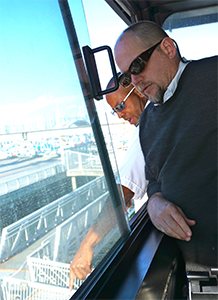 |
|
Capt. Crawford offers guidance for Capt. Greg Urban as he steers to the dock at the ferry terminal outside AT&T Park in San Francisco. “Slow is a bump, fast is a crash,” Crawford said. |
Cetus had 18 passengers on the trip’s first leg between Pier 41 and Alameda. It’s a light load but about right for a midweek, midafternoon voyage in the fall. The ferries are often loaded to capacity during the rush-hour commute.
“Our next run, you’ll see we leave at 5:20 (p.m.),” Crawford said. “That is a big run. We’ll have anywhere from 250 to 400 passengers, which is our maximum. The Hydrus is running, and they will follow up 20 minutes later and they’ll probably take another two or three hundred.”
It was sunny and breezy on this September day, weather conditions that are fairly typical for the region. Winds gusted to 20 knots and seas were running 2 to 4 feet. The Central Bay was nearly empty, with the occasional sailboat on the horizon but little commercial traffic. That’s not always the case. San Francisco Bay can clog with sailboats and powerboats during the weekend, and busy ports in Oakland, Richmond and Redwood City attract dozens of large ships each month.
Hydrus and Cetus generally serve the Central Bay region, which includes San Francisco, South San Francisco, Alameda and Oakland. WETA also has routes to Vallejo an hour north, and this fall it plans to launch a new service to Richmond, which is north of Oakland.
Despite the chop, Cetus sped across the bay at 27 knots. Roughly halfway across, the ferry passed under the San Francisco-Oakland Bay Bridge, which spans 4.5 miles and carries 260,000 vehicles per day. A few minutes later, Crawford turned to port at the entrance channel to Oakland Harbor.
“This run is pretty good. The only hiccup is we are going into a busy container port,” Crawford said, referring to the Port of Oakland. It attracts some of the largest ships in the world and in 2017 moved a record 2.42 million TEUs.
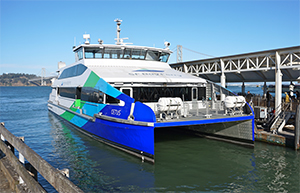 |
|
Cetus awaits passengers at the San Francisco Ferry Building Terminal. The vessel and its sister Hydrus can each accommodate 400 riders, capacity that is often needed in the rapidly growing Bay Area. |
He pulled back on the throttles as Cetus entered the channel, which has container terminals lining its north side. Large Maersk, NYK Line and Matson containerships were in port. Ferry captains generally slow down when they approach commercial vessels as a courtesy, Crawford said. Hydrus and Cetus were designed to generate a low wake, but even small waves can create headaches for tugboats working alongside the massive ships.
The only other boat underway was the oncoming Hydrus, which passed Cetus on the port side for a return trip to San Francisco. Crawford, meanwhile, lined up his approach into Alameda. From the starboard wing station, he steered Cetus against the pier for a smooth landing.
Ten minutes later, deck hand Sergio Aldana hauled in the lines and prepared Cetus for its next hop to Oakland. Crawford activated the bow thruster and crept away from the terminal and into the harbor.
He soon turned to port as Cetus approached the Oakland terminal, which extends about 100 yards into the waterway. Again, he moved to the starboard wing station to guide the ferry into the dock.
Depending on the winds and tide, Oakland’s dock can be a challenge. Flood tide tends to push the ferry against the landing, often requiring reverse thrust to counteract the current. On this occasion, the ebb tide helped ease Cetus into position. Crawford uses the thruster mostly for getting off certain piers but rarely for docking.
Hydrus and Cetus are powered by twin 1,875-hp MTU 12V 4000 M64 engines, one in each pontoon, with the aftertreatment boxes installed above the engines. The MTU mains turn 50-inch, five-blade Michigan Wheel props through ZF Marine 7600 reduction gears. Electrical power comes from twin John Deere 99-kW generators.
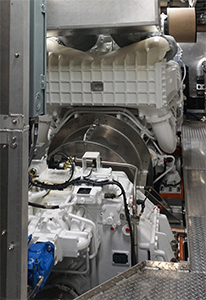 |
|
Both ferries are powered by twin MTU Tier 3 engines outfitted with exhaust aftertreatment. |
Vigor was the prime contractor for the construction of Hydrus and Cetus. Nichols Brothers Boat Builders of Freeland, Wash., served as a subcontractor and handled the superstructures.
WETA also has three high-speed ferries under construction at Dakota Creek Industries in Anacortes, Wash. The North Bay-class ferries will be able to accommodate 445 passengers and will be the first in the U.S. with Tier 4 MTU engines with aftertreatment, Sanchez said. The vessels will be capable of 34 knots and cost about $19.2 million each. The first delivery is expected this fall.
After unloading was complete in Oakland, Urban took the controls for the return trip to San Francisco. He backed Cetus off the dock and steered west toward San Francisco Bay, essentially retracing the ferry’s route through the channel. Upon returning to the bay, Urban turned to the southwest and throttled up to 26.5 knots.
With no passengers on board and time before the 1720 trip, Urban steered toward the dock alongside AT&T Park. Under Crawford’s watchful eye, he practiced his approach and docking technique. Crawford offered an occasional suggestion about speed and angle of approach.
“Slow is a bump, fast is a crash,” Crawford warned.
Crawford began with Blue & Gold Fleet as a photographer in 1994. He later worked in the ticket booth and then as a deck hand before earning his captain’s license in 2002. He said company veterans taught him to operate the ferries, and he hasn’t forgotten those lessons.
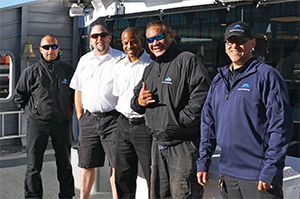 |
|
Blue & Gold Fleet’s roster of ferry personnel includes, from left, deck hand Stefan Dimitrov, Capt. Greg Urban, Capt. Dushan Crawford, lead deck hand Orcutt Falo and deck hand Sergio Aldana. |
“I try to teach the things I learned from my training captains,” he said.
From the starboard wing station, Urban steered Cetus against the pier with a negligible bump. To practice backing out, he applied the thruster to twist the vessel away from the pier. After spinning around, he sailed north to the San Francisco Ferry Building Terminal.
Urban, who earned his captain’s license in 1989, said he wanted to be a tugboat captain since age 5. He briefly joined Blue & Gold after a long career working on tugboats, including 11 years as a captain of offshore tugs. He has since returned to tugboat work full time.
The short hop from AT&T Park to the Ferry Building Terminal was over in a couple of minutes. Urban executed his approach near construction equipment being used to build two new ferry gates.
Based on the afternoon crowd, the extra capacity will be needed. Hundreds of passengers were already lined up for the 1720 boat, with more arriving by the minute. That’s good news for Crawford and the 82 mariners who work for Blue & Gold Fleet on WETA ferries.
“Look at my office. Look at my view,” he said. “I love this.”
From the wheelhouse of a high-performing new ferry, facing one of America’s great cities, it wasn’t a stretch to understand why.

